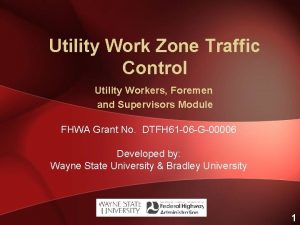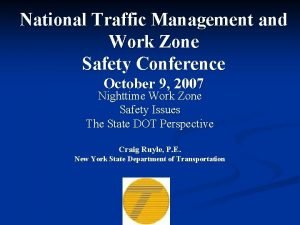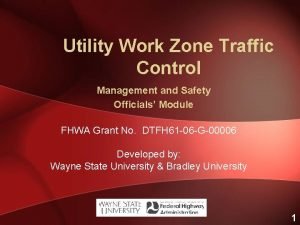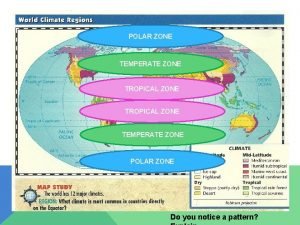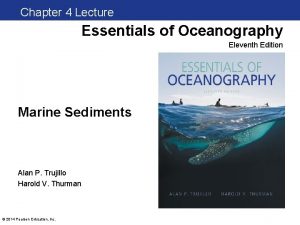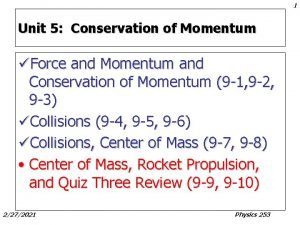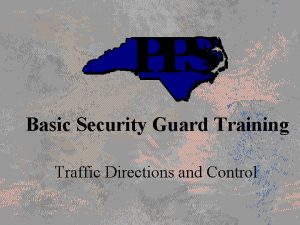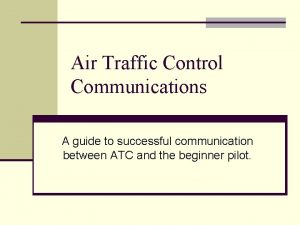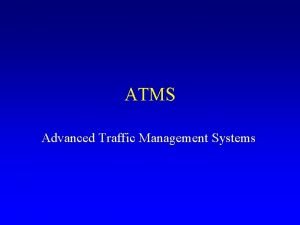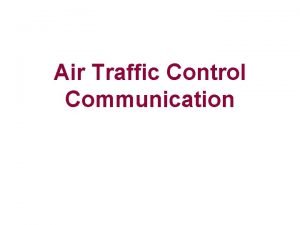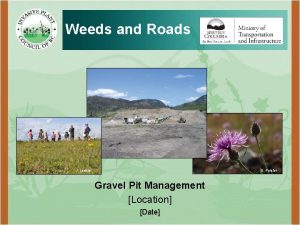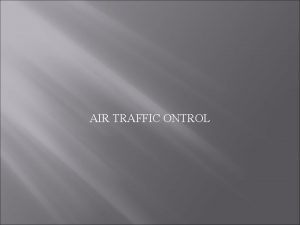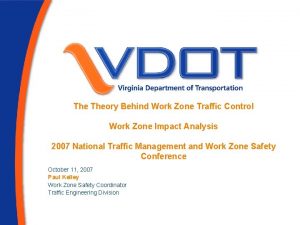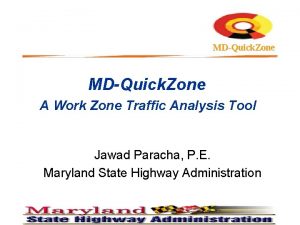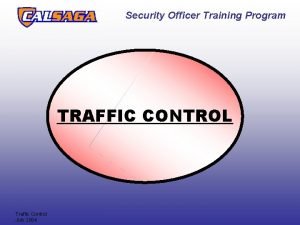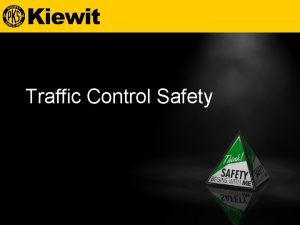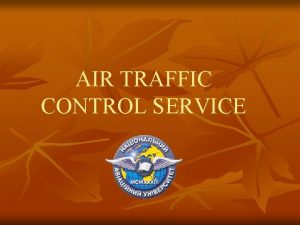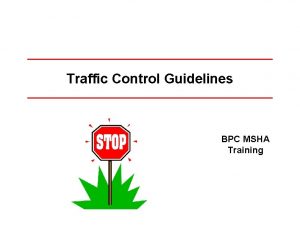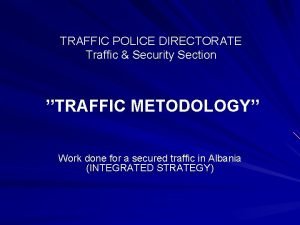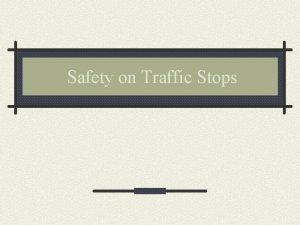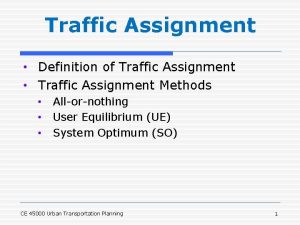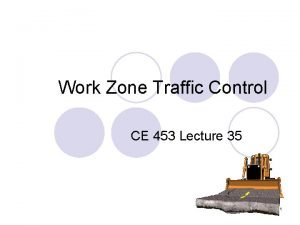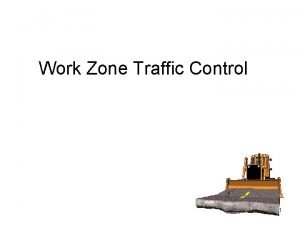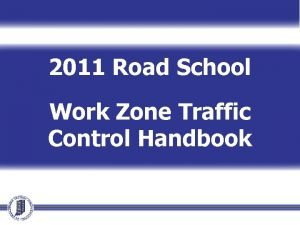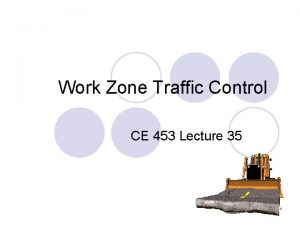Work Zone Traffic Control Gravel Roads Work Zone

























- Slides: 25

Work Zone Traffic Control Gravel Roads

Work Zone Traffic Control Gravel Roads Challenging Facilities to Complete WZTC on • Typically are low to very low volume roads - So is the risk really worth the effort? • The work itself gets in the way of traffic control - No place to place cones (if you wanted them) - On some roads simply finding a location to place signs can be a challenge • Most operations lack staff to complete WZTC • The work zone is constantly moving and typically has a long linear length

Work Zone Traffic Control Gravel Roads The Work Does Pose Hazards to the Public and to Us • A survey of Oregon Counties found that most have had accidents or close calls with private parties while completing the work (none were serious) • Very slow moving equipment in the road • Limited visibility • Equipment can occupy much of the road • “Gigantic” berms • The road itself can contribute to a hazard, i. e heavily potholed or washboarded roads







Work Zone Traffic Control Gravel Roads ORS 810. 200 The Oregon Transportation Commission may exercise the following authority with respect to the marking, signing and use of traffic control devices in this state: (a) The commission shall adopt a manual and specifications of uniform standards for traffic control devices consistent with the provisions of the vehicle code for use upon highways in this state.


Oregon Temporary Traffic Control Handbook Budget Overview December 2011 • By way of Oregon law, all local governments should (must) use this handbook for all temporary traffic control completed by our forces. • My guess is almost none us do for WZTC on gravel roads • Creates risk and liability for us as we are not following published standards.

Jackson County Roads & Parks Stationary Closure with Flaggers (Diagram 320)

Operations with Moving Flagger Stations (Diagram 325)

(Standard notes that this can only be used for work spaces of 200 feet or less) Self-Regulating Lane Closure (Diagram 350)

(Standard specifically notes that this standard does not apply to work on gravel roads) Mobile Operation on Two-Lane Roads (Diagram 110)

Oregon Temporary Traffic Control Handbook December 2011 • ODOT recognized that the standards don’t work for gravel roads • Gave us an out – we should take advantage of that • Needs to be a formalized process

Work Zone Traffic Control Gravel Roads In 2012 OACES completed a survey of Oregon Counties to determine current WZTC practices on gravel roads • All counties use flaggers with full work zones for more complex work • Grading operations rarely use flaggers – almost never • Most common work zone is a single ROAD WORK AHEAD, ROAD MACHINERY AHEAD, or GRADER AHEAD on each end and - nothing else. (my personal favorite was a county that bolted a ROAD WORK AHEAD on the front and back of the grader and called it good)


Work Zone Traffic Control Gravel Roads 2012 OACES survey continued • Several counties set one sign – completes first pass – sets second sign at turn around for second pass • A few counties use two signs on each end • Generally use two standard warning signs in combination ROAD WORK AHEAD + ROAD MACHINERY AHEAD or ROAD WORK AHEAD + GRADER AHEAD or Adding a SLOW sign to one of the signs above. • Cones – used by several counties • • Often spaced intermittently to keep drivers attention that they are in a work zone. Also placed at the beginning of berms

Work Zone Traffic Control Gravel Roads 2012 OACES survey continued • Who sets the signs? • • • Two counties use grader chasers (support staff that place signs, clear culverts, etc. ) Most grader operators work alone and set their own signs Water or rock truck drivers set them if they are present • Work zone length varied widely • • • 1 -mile or less was most common 2 -5 miles normal for some Central and Eastern “Work zone length? I don’t know, I tell them to grade outward until lunch, eat, turn around and come back and call it a day. ”

• • • Few standards 2009 MUTCD, Parts 5 and 6 give little help Some states have standards (not sure we want to follow those) Work Zone Safety Consortium completed a guidance document funded through a FHWA grant Best Practices from the counties

Work Zone Traffic Control Gravel Roads Recommendations 1. If your not using the Oregon Temporary Traffic Control Handbook for all your work (which none of us are) – Develop your own written and reviewed standards 2. OACES is going to develop a couple of model standards 3. If an operation is more than simple grading – increase your traffic control 4. Consider increasing your signs to more than one 5. Consider intermittent cones where width allows and

Work Zone Traffic Control Gravel Roads Recommendations 6. No night work and consider impact of fog 7. Use roto-beams on equipment 8. Consider adding flags to corners of grader moldboard 9. Watch the length of your work zones - 1 -mile or less for limited sight distance roads - more than 1 -mile probably okay in open county 10. Keep your berms easily traversable for expected traffic 11. Don’t take chances

Work Zone Traffic Control Gravel Roads Questions or Comments
 Modern roads vs roman roads venn diagram
Modern roads vs roman roads venn diagram Shoulder taper length
Shoulder taper length Nysdot wztc standard sheets
Nysdot wztc standard sheets Utility work zone traffic control
Utility work zone traffic control Temperate regions countries
Temperate regions countries Neritic zone climate
Neritic zone climate Source zone transition zone and floodplain zone
Source zone transition zone and floodplain zone Incomina
Incomina All traffic solutions
All traffic solutions Rolls theorem
Rolls theorem Nadeem asghar
Nadeem asghar Cream being whipped physical or chemical
Cream being whipped physical or chemical Is bleaching your hair a physical or chemical change
Is bleaching your hair a physical or chemical change Ned gravel
Ned gravel Clicker gravel transport
Clicker gravel transport Submerged gravel wetland
Submerged gravel wetland A hopper drops gravel at a rate of 75 kg
A hopper drops gravel at a rate of 75 kg Is separating sand from gravel a physical change
Is separating sand from gravel a physical change Traffic control austin
Traffic control austin A sign that alerts you to possible hazards
A sign that alerts you to possible hazards Traffic direction training
Traffic direction training Air traffic control alphabet
Air traffic control alphabet Atms traffic control
Atms traffic control Apache traffic control
Apache traffic control Atc communications
Atc communications If 7 cards are dealt from an ordinary deck
If 7 cards are dealt from an ordinary deck

